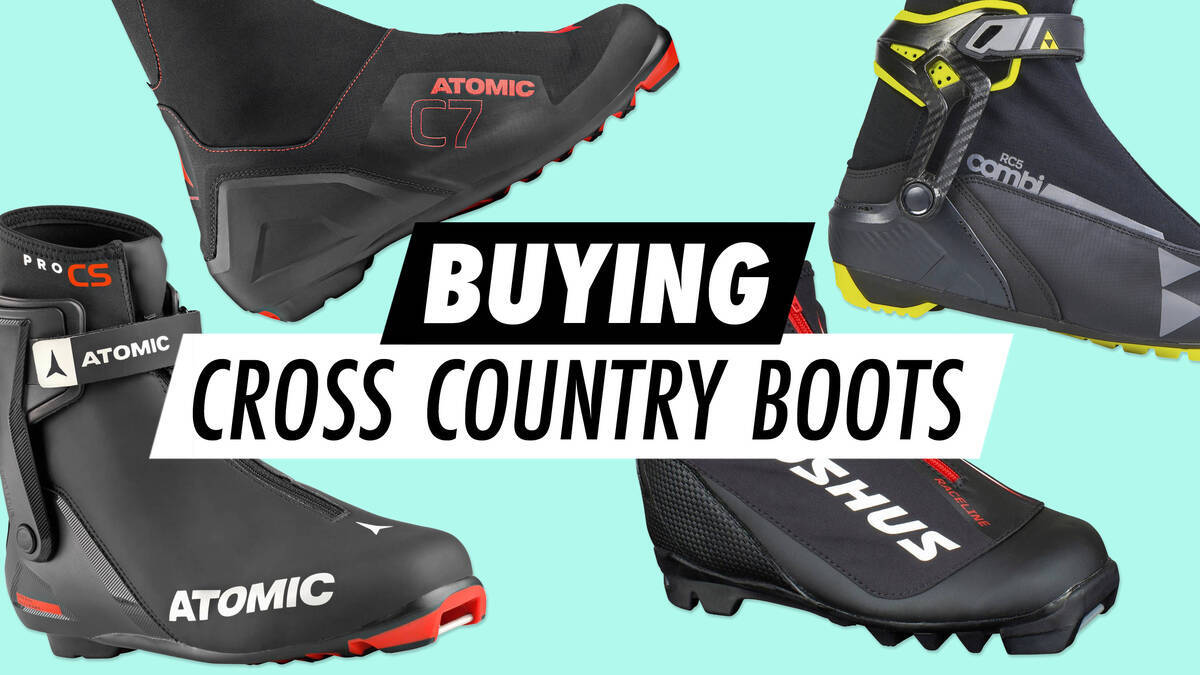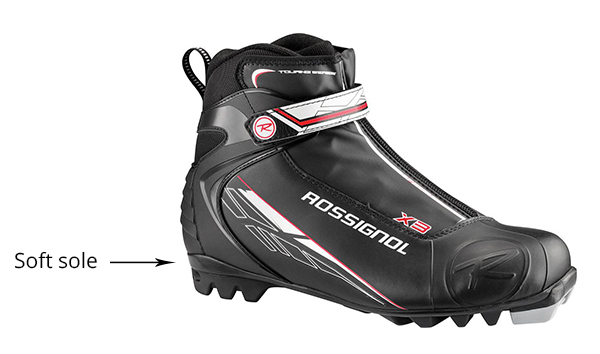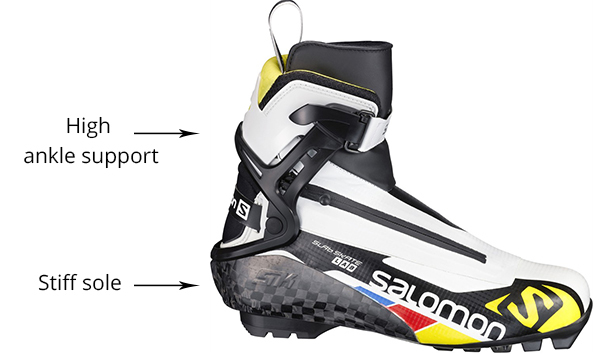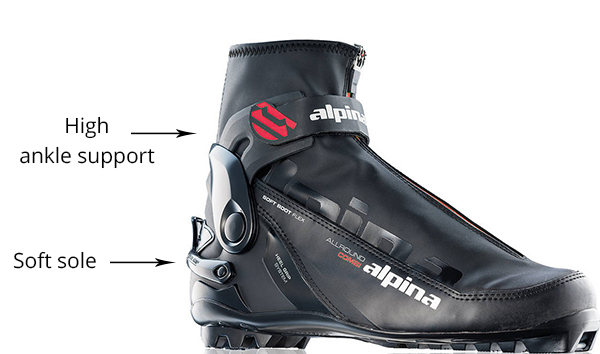Руководство по покупке ботинок для беговых лыж

Выбор подходящих ботинок для беговых лыж очень важен для вашего катания, независимо от того, какой стиль вы выбираете. Чтобы помочь вам принять взвешенное решение, мы собрали несколько важных советов.
Размер ботинок для беговых лыж: Какой размер ботинок для беговых лыж мне нужен?
Ботинки для беговых лыж должны быть достаточно плотными, чтобы ваши пятки оставались на месте во время катания. Однако главное - избегать слишком тесной или слишком свободной посадки. В передней части ботинка должно быть достаточно места для того, чтобы немного пошевелить пальцами ног, чтобы не повредить пальцы, сдавливая их. Кроме того, если ботинки слишком тесные, это может нарушить равновесие и кровообращение. Большинство людей используют более толстый носок в ботинках для беговых лыж. В таких случаях ботинки должны быть примерно на полтора-полтора размера больше, чем ваши беговые кроссовки.
При покупке ботинок для беговых лыж в SkatePro обязательно следуйте руководству по подбору размера для конкретного ботинка, который вы рассматриваете. Это позволит вам сравнить длину вашей стопы с конкретными ботинками, которые вы рассматриваете. В наших руководствах по размерам мы часто даем советы, основанные на отзывах покупателей.
Выбирайте беговые лыжи в зависимости от их предназначения: Прогулочные или соревновательные беговые лыжи
Покупая ботинки для беговых лыж, вы должны соотнести свой выбор с конкретным контекстом, в котором вы будете их использовать. Конструкция ботинок для беговых лыж варьируется в зависимости от их предназначения: для неспешных прогулок или для участия в знаменитых соревнованиях Vasaloppet в Швеции.
Ботинки для кросс-кантри на отдыхе
Для любительского использования важны комфорт и простота в использовании. Ботинки для бега по пересеченной местности ориентированы на то, чтобы вашим ногам было тепло и удобно, а расслабленная посадка сохраняет комфорт во время длительных поездок. Для тех, кто ищет ботинки для бега по пересеченной местности для начинающих или детей, которые хотят наслаждаться временем, проведенным на снегу, эти характеристики также желательны.
Соревновательные ботинки для кросс-кантри
Ботинки, предназначенные для спортивных соревнований, имеют более плотную и точную посадку. Плотная посадка максимально увеличивает передачу энергии от ног к лыжам. В таких ботинках используются легкие материалы, такие как карбон, чтобы снизить вес до минимума и повысить скорость и маневренность. В соревновательных беговых лыжах меньше внимания уделяется комфорту, и они, конечно же, предназначены для опытных лыжников.
Типы ботинок для беговых лыж
Существует 4 различных типа ботинок для беговых лыж, и вам, конечно же, следует купить пару, предназначенную для того стиля катания, которым вы собираетесь заниматься. В этом разделе мы рассмотрим и пятый тип ботинок для беговых лыж, которые предназначены для катания на роликах.
Классические ботинки для беговых лыж - гибкая подошва

Ботинки для беговых лыж классического стиля имеют мягкую и гибкую подошву. Это связано с тем, что возможность сгибать подошву в передней части стопы очень важна для выполнения классических лыжных ходов.
Как опытные, так и начинающие лыжники смогут найти подходящие ботинки в этой категории, если они занимаются классическим бегом. Начинающим лыжникам стоит обратить внимание на то, чтобы ноги были в тепле, используя более толстую подкладку, а также выбирать ботинки, обеспечивающие поддержку пятки и лодыжки. Этот тип ботинок хорошо подходит для ежегодных зимних каникул или для тех, кто впервые участвует в соревнованиях Vasaloppet.
Классические ботинки для беговых лыж для более опытных лыжников зачастую легче, чем ботинки для начинающих. Они имеют более тонкую подкладку, которая уменьшает вес и не дает ботинкам нагреваться внутри во время движения. Кроме того, они имеют более жесткую пятку для большей передачи энергии.
Откройте для себя наш выбор классических ботинок для беговых лыж.
Ботинки для конькового хода - высокая поддержка лодыжки и жесткая подошва

Ботинки для коньковых лыж сконструированы иначе, чем классические ботинки для беговых лыж. Причина в том, что походка на коньках сильно отличается от похода на классических лыжах. При катании на коньках большая нагрузка приходится на лодыжки из-за боковых ударов. Чтобы обеспечить достаточную поддержку, ботинки для коньков имеют более жесткий и высокий голеностопный бандаж, который может быть изготовлен из пластика или карбона.
Коньковые ботинки также отличаются от классических ботинок для беговых лыж тем, что у них жесткая подошва. Это означает, что вы можете отталкиваться всей подошвой, в то время как в классическом стиле вы отталкиваетесь только передней частью стопы. Благодаря этому вы получаете большую силу удара.
Откройте для себя наш выбор ботинок для конькового хода.
Ботинки для беговых лыж Combi - гибкая подошва и высокая поддержка лодыжки

Если вам нравится кататься и на коньках, и на классических лыжах, но вы хотите иметь только одну пару ботинок - или если вам нужна дополнительная поддержка голеностопа для классического кросс-кантри, - стоит рассмотреть пару комбинированных ботинок.
Комбинированные ботинки сочетают в себе особенности классических ботинок и ботинок для конькового хода. В результате получается ботинок с надежной поддержкой голеностопа, который хорошо подходит для катания на коньках и сохраняет устойчивость лодыжек при ударах. В то же время подошва мягкая, как у классических ботинок, поэтому вы можете перекатывать ноги при выполнении классических отталкиваний. В коньковом ботинке это сделать очень сложно.
Откройте для себя наш выбор ботинок для беговых лыж в наших подборках " Ботинки для конькового хода " или "Классические ботинки для беговых лыж".
Лыжные ботинки для бэккантри - устойчивые к погодным условиям и прочные
Лыжные ботинки для бэккантри предназначены для путешествий по бездорожью и обладают целым рядом характеристик, которые позволят вам получить максимум удовольствия от поездок. Они часто выглядят как обычные туристические ботинки, а их конструкция позволяет держать ноги в тепле и комфорте. Эти особенности незаменимы для искателей приключений, отправляющихся в длительные походы в дикую природу. Высокие манжеты поддерживают лодыжки, а также препятствуют попаданию снега внутрь.
Подводя итог, можно сказать, что если вы собираетесь отправиться в бэккантри, вам нужны ботинки, которые предназначены для этой цели, а это значит, что вам нужны прочные, удобные и водонепроницаемые ботинки nnn bc.
Откройте для себя наш выбор лыжных ботинок для бэккантри.
Ботинки для беговых лыж - вентиляция имеет ключевое значение
Большинство людей используют свои ботинки для беговых лыж для межсезонного катания на роликах, и это прекрасно. Если вы попробовали это решение и чувствуете, что летом во время тренировок вашим ногам становится слишком жарко, мы рекомендуем вам купить летние ботинки для роликовых лыж с креплениями NNN (NIS). Эти ботинки легче и лучше вентилируются, чем традиционные ботинки для беговых лыж.
Обратите внимание, что ваши ботинки для беговых лыж будут быстрее изнашиваться, если вы будете использовать их для катания на роликах, особенно в районе молнии. Чтобы продлить срок службы ботинок, очищайте их от грязи и песка и храните в сухом месте, когда они не используются.
Ознакомьтесь с нашим ассортиментом ботинок для роликовых лыж.
Совместимость ботинок и креплений для беговых лыж
Совместимость ботинок и креплений для беговых лыж очень важна, прежде чем принимать решение о покупке. Выбор ботинок для беговых лыж, которые подходят к вашим креплениям, или наоборот, зависит от соответствия подошвы ботинок соответствующим креплениям.
В таблице, представленной ниже, вы можете оценить свои возможности двумя способами. Во-первых, определите свои ботинки для кросс-кантри, чтобы узнать все совместимые типы креплений. Или же определите крепления на ваших лыжах, чтобы выяснить, какие ботинки с ними совместимы. Такой подход облегчает выбор ботинок, совместимых с вашими креплениями.
Таблица совместимости ботинок и креплений для кросс-кантри
| Крепления NNN | Крепления Prolink | Крепления Turnamic | Крепления SNS Profil (классика) | Крепления SNS Pilot (скейт) | Крепления NNN BC | |
|---|---|---|---|---|---|---|
| Ботинки Alpina | x | x | x | |||
| Ботинки Atomic Prolink | x | x | x | |||
| Atomic SNS Pilot Boots (Skate) | x | |||||
| Atomic SNS Profil Boots (Classic) | x | |||||
| Сапоги Fischer | x | x | x | |||
| Сапоги Мадшус | x | x | x | |||
| Ботинки Rossignol | x | x | x | |||
| Ботинки Salomon Prolink | x | x | x | |||
| Salomon SNS Pilot Boots (Skate) | x | |||||
| Ботинки Salomon SNS Profil (классические) | x | |||||
| Ботинки Alpina, Fischer или Madshus NNN BC | x |
Более подробную информацию о совместимости ботинок и креплений для кросс-кантри вы найдете в нашем руководстве "Совместимость креплений для кросс-кантри и роликовых лыж".
